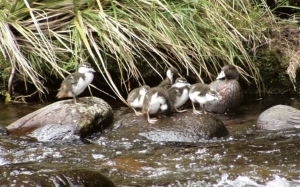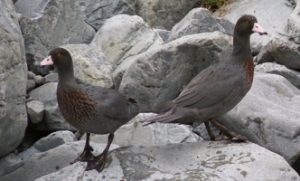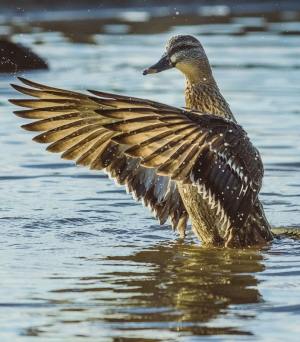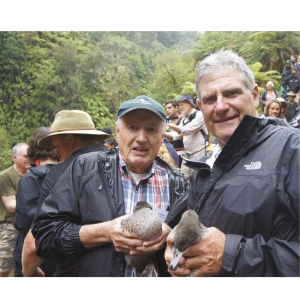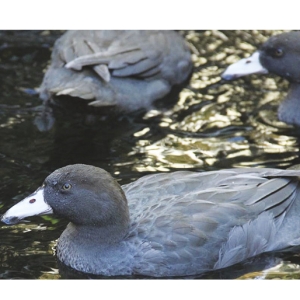Displaying items by tag: Blue Duck
Report on Operation Whio (Blue Duck)
Mr David McNeil opened his remarks commenting that the decision by the Wildlife Service to capture and supply Ducks Unlimited with 10 pairs of birds was received with great enthusiasm as DU had long considered that the development of expertise with this species (before numbers in the wild are affected by habitat reduction and other causes to a dangerously low level)was a logical move.
Mr McNeil outlined background to the project and gave details of experience achieved in adapting the birds to new diet and conditions during acclimatisation. Praise was given to Mr and Mrs I.H. Pirani and Mr M. Powell for their efforts in rearing the birds under aviary conditions — he said it would be difficult to imagine a greater change from conditions in the wild but commented that those involved with rearing had been astonished at the birds' natural quietness and lack of concern when approached closely — perhaps a fatal flaw in their nature. Pair bonding was discussed and experiences with natural pairing shared with the audience.
Overall it was felt that a great deal of progress had been made and Mr McNeil said he hoped the Wildlife Service could catch the balance of their agreed total as a permanent nucleus of captured birds was essential to the survival of the species. The Wildlife Service was being kept fully informed of Ducks Unlimited‘s progress. The only disturbing factor had been the recent reports of poaching of Blue Duck and other wildlife species for overseas markets, and Mr McNeil said Ducks Unlimited would assist with publicity and conservation of this unique species. A member requested that a remit be presented by Ducks Unlimited to the Minister of the Environment inquiring if anything had been done concerning alleged poaching recently reported in the press.
The President reported that he understood a special task force had been set up by the wildlife Service to investigate the matter of poaching Blue Duck and other species and undertook that a letter would be written to the Minister expressing the organisation's concern and seeking clarification of the position.
Whio care pays off
Peter said that 33 captive birds have been bred this summer.
“It’s also been the best season in the wild that we’ve had.”
The birds had been hardened to fast flowing water at Peacock Spring ready to be introduced to real fast flowing rivers.
A hardening facility is planned at the National Trout Centre (see story page 12) which means less travel for North Island birds.
Each of these new birds has been micro chipped so they could be identified if found again.
Finishing school for whio
National Whio Recovery Group leader Andrew Glaser said the North Island whio rearing facility will help recover the national whio population by allowing whio ducklings to ‘grow and train’ in a more natural environment. “It’s like a finishing school for whio, where they can learn to swim and feed in fast flowing water, giving them a better chance of survival when they are released back into the wild.
“A facility like this will mean more ducklings survive the transition from captivity back to the wild, so they can establish their own territories and find mates. This will help us boost the population in the wild,” he said. Andrew pointed to the success of restoring the whio population in Egmont National Park which has been achieved through a combination of predator control activities and the release of captive reared birds over the past nine years.
“This is the first successful restoration of a whio population in New Zealand. It is a credit to the Taranaki community and shows what can be done with an effective trapping regime and WHIONE (lifting eggs and hatching and rearing in safe captivity).”
The whio population in Egmont National Park has grown from almost nothing to 24 pairs of whio since 2005. This breeding season a record 36 ducklings hatched in the park, although it’s not yet known how many of these will survive into adulthood.
Two whio rangers on the Manganui o te Ao River – searching for whio travel on unique water craft manufactured by our multi talented DOC rangers!
are located at Te Anau and at Peacock Springs near Christchurch. Using South Island facilities means extended travel for North Island whio ducklings. Constructing a low cost facility in the North Island reduces the
risk and expense associated with this.
The facility will cost an estimated $110,000 with funding from the Whio Forever
partnership, DOC and the Central North Island Blue Duck Charitable Trust.
Construction should be completed for the arrival of the first ducklings in September this year.
The support of Genesis Energy is enabling DOC to double the number of fully secure whio breeding sites throughout the country, boost pest control efforts and enhance productivity and survival for these rare native ducks.
Whio Forever
Whio Forever wins green ribbon award
The Whio Forever recovery programme won the Ministry for the Environment Green Ribbon Award this year for protecting our biodiversity.
The Awards recognise outstanding contributions of individuals, organisations,
businesses and communities to protecting and enhancing New Zealand’s environment.
The National Whio Recovery Programme is a partnership between Genesis Energy, the Department of Conservation, Forest and Bird and the Central North Island Blue Duck Charitable Trust. It is focused on the protection and recovery of the whio, a threatened native bird and supports whio security and recovery
sites across the country.
Genesis Energy Environmental Manager, Bonny Lawrence and the Department of Conservation Whio Recovery Group Leader, Andrew Glaser accepted the award from the department’s Director General, Lou Sanson.
eight security sites Receiving the award DOC’s Whio Recovery Group Leader Andrew Glaser said it was exciting the Whio Forever partnership was
acknowledged, as the Awards recognised a wide range of amazing environmental initiatives around New Zealand.
Andy also acknowledged the many whio practitioners and community supporters
who have contributed to the success of the programme.
The whio recovery programme also funds WHIONE projects (Whio Operation Nest Egg) that allows wild whio populations to be boosted with ducklings hatched and raised in safe havens, then released into the wild.
Dan (the Blue Duck man) Steele
Ducks Unlimited director Dan Steele, is one of this year’s five Nuffield New Zealand Scholarship winners.
- Bede O’Connor, a West Coast dairy farmer.
- Ben Allomes, Woodville dairy farmer.
- Satwant Singh who is part of the Fonterra Commodity Risk and Trading team and also works on her family dairy farm near Morrinsville.
- And finally Sharon Morrell a regional leader with Dairy NZ based in Rotorua.
My favourite New Zealand duck
Jamie Steer University of Auckland
I was talking with a guy the other day about ducks and somehow got on to discussing favourites. His was the blue duck because it’s on the $10 note.
He said, ‘That’s a bird that knows how to sell itself’.
‘Maybe that’s true,’ I said, ‘but I haven’t seen many around recently so I wouldn’t know’.
We agreed that they had a pretty great strategy 800 years ago. Good for them.
I told him my favourite was the New Zealand grallard, the bastard love child of the introduced mallard and the native grey duck, and now New Zealand’s most common duck. This at first seemed to both perplex and bewilder him but, once he’d settled down, I ran him through my reasons and in the end he accepted that I’d made the more compelling choice.
This is basically what I said.
Grallards are one of the world’s newest birds. They came into existence not long after mallards were introduced to New Zealand in the mid-19th Century. Mallards took a shining (wink wink) to the grey duck and the rest is history. From what I hear the grey is partial to a bit of mallard action too so it’s a veritable love in. People talk a lot about birds that haven’t changed in ages but I like the versatile new chick on the block.
Grallards are all over the place. I drive around a bit and there aren’t many water bodies I don’t see grallards on. Clearly they’re loving it here. People shoot a tonne of them every year and they just keep coming back. They’re the duck version of The Terminator. I respect a bird that can take all the crap people have thrown at them over the years and still keep on kicking. I take my son down to feed the ducks and they’re always there ready and obliging.
Grallards are unique to New Zealand. I searched around and haven’t found grallards anywhere but here. There’s something similar in Australia but they’re derived from mallards mixed with the Australian sub-species of grey duck. I reckon they look different over there too. It’s neat to have another locally unique duck, especially one that’s got such an interesting history. Millions of years of evolution in those genes and it didn’t end with their parent species. They’re the biological version of fusion cuisine.
Grallards could teach people a thing or two. Some people are so distraught about losing biodiversity that they can’t see the gains happening right in front of them. Grallards have accepted people and the changed environments that they live in. They don’t distinguish between native and introduced species, or between pristine and modified environments. They get on with living their lives and the world is a more diverse, interesting and vibrant place for it. While some other species have ‘evolutionary potential’ grallards are busy realising theirs.
It’s like they’re sitting there quaking, ‘Here I am loving life and the world isn’t going to end’.
Maybe there’s a lesson in there, I don’t know.
Jamie Steer
Cushy start for baby Whio
Playing mother duck comes naturally to Judy Fentress, the woman who can’t say no to an egg. Therefore it is not surprising she recently hatched three Whio ducklings – in an incubator. Well what did you think?
Judy has been in the hatching business for some time and in 2012 Flight ran a story about her and her passion for ducklings.
She thought we might be interested to know about the three Whio ducklings. Judy said she used the very same incubator, mentioned in the article in 2012. It was given to her by Hamilton DU members. In August this year she was given the Blue Duck eggs to hatch for the Otorohanga Kiwi House and Native Bird Park (Judy is an honorary life member after 15 years service as treasurer and helping with their wildlife breeding programme).
On September 8, these three little Whio ducklings hatched.
Some of us may remember the cheeky pukeko that became the star of the Genesis Power TV adds which were to help fund the protection of the Whio. Well Judy was the person who hatched that “cheeky pukeko”.
“Now I have hatched these three little Whio ducklings that will get to benefit from that very project.”
July was given another old incubator in 2013 from a DU member in Rangiwahia. “I cleaned it up, installed a digital thermometer, some egg racks and a few hatching baskets.
This incubator is now working perfectly and has been hatching all sorts of eggs over the past few years.”
During the egg laying season, Judy said she can have 3 to 4 large incubators going and full of various eggs.
“I incubate a lot of rescue eggs, where the nest or mother has been destroyed, or left the nest. If the eggs get into my incubators soon enough, there is a very good chance they will survive. I hatch a lot of rescue mallard eggs (60 so far this year) from Fish & Game as well as individuals finding eggs in need of help.”
Well done Judy, and long may you keep up the good work for some time come.
Restoring the balance for whio
Horizons Regional Councillors joined DOC representatives and iwi at Blue Duck Station in February 2017 for a whio release, during a tour of the northern parts of the ManawatuWhanganui Region. Blue Duck Station set within the Kia Wharite project, has seen Horizons, DOC, Whanganui iwi and
private landowners working in the private lands and remote forests around Whanganui National Park to improve land, water and biodiversity, while enhancing community and economic wellbeing. Kia Wharite is one of the largest projects of its kind in New Zealand in scale and scope.
Back in February, way before the weather bomb hit Blue Duck Station, (see page 7) Horizons Regional Councillors joined the Department of Conservation (DOC) deputy director general operations, Mike Slater, and iwi representatives for the release of 14 whio at Blue Duck Station.
The whio release was a hands-on opportunity to show how Kia Wharite, a collaborative biodiversity project in the Whanganui/ Ruapehu districts, is directly contributing to the survival of native species.
Since 2008, Horizons, DOC, Whanganui iwi and private landowners have been working in the private lands and remote forests around Whanganui National Park to improve land, water and biodiversity health, while enhancing community and economic wellbeing. Kia Wharite is one of the largest projects of its kind in New Zealand in terms of scale and scope.
The Kia Wharite project spans over 180,000 hectares and includes a mixture of private land and parts of the Whanganui National Park, the second largest lowland forest in the North Island. This remote area is home to the largest population of Western North Island brown kiwi and plays host to many native bird and plant species.
Possums, goats, stoats and other predators have threatened the health of the forest and put the long-term future of its inhabitants in jeopardy.
Horizons Councillor Bruce Rollinson said as part of the project extensive possum control operations have been undertaken by Horizons and OSPRI on rated land, and DOC on crown land. OSPRI have signalled a phased withdrawal from areas inside the project sites, as these areas are declared TB free. Currently approximately 150,000 hectares of land has regular possum control undertaken in the project area.
This work, alongside pest and weed control, protecting bush and wetlands and monitoring threatened native species, is also why it was possible to release 14 whio into the Kaiwhakauka Stream. Here, whio are protected on the river through a network of traps managed by Blue Duck Station volunteers to target stoats, said Cr Rollinson.
Predator control is carried out in the wider whio security site by Horizons and DOC; over 85 km of trap lines are in place along the Retaruke and Manganui o te Ao rivers, providing necessary protection for whio.
Department of Conservation deputy director general operations Mike Slater said with a population of fewer than 3000, this national whio security site is one of eight locations identified across the country as being essential for whio recovery.
With the support of Genesis Energy, DOC has been able to double the number of fully secure whio breeding sites, boost pest control efforts and enhance productivity and survival of these rare native ducks. The ultimate goal of this security site is to achieve protection to 50 breeding pairs, said Mr Slater.
Whio are adapted to live on fast-flowing rivers so finding them means you have also found clean, fast-flowing water with a good supply of insects. This makes whio important indicators of ecosystem health, they only exist where there is high quality, clean and healthy waterways.
It is not just whio and the environment that benefit from the project. Horizons and DOC believe there are positive economic returns to be had from the project. Blue Duck Station is the most obvious example.
The sheep and beef cattle farm, located 55km south-west of Taumarunui, is set on 2915 hectares of medium to steep hill countryDuck Station owner and manager Dan Steele said grazing areas have been deliberately offset by native bush and manuka. “Through the Kia Wharite project, we have
worked closely with Horizons and DOC to develop a sustainable land plan, and fence ofselected farm areas to protect native fauna and flora,” said Dan Steele.
“The Station has approximately 450 traps for stoats, mustelids, feral cats, rats, mice and hedgehogs; all enemies of the blue duck as well as other native species. In partnership with Kia Wharite, we maintain and reset the traps approximately every two weeks; this is undertaken mainly by our olunteers or ecowarriors as we call them.
“Embracing the environment in this way provided the perfect place to set up a lodge and tourism operation. In a relatively short time we have grown to approximately 8000 visitors a year, many of whom become ecowarriors during their stay,” said Dan Steele.
Cr Rollinson said Kia Wharite is proving to be a successful approach, with the project already exceeding some of its goals. “It shows what can be accomplished when organisations join forces and work collaboratively.”
Whio in decline
Whio in decline…
The whio (blue duck) is one of New Zealand’s ancient endemic waterfowl species and is classified as Threatened (Nationally Vulnerable) in the New Zealand Threat Classification System 2012, and listed as Endangered on the IUCN Red List of Threatened Species.
North Island and South Island whio populations are genetically distinct (though they are not described as sub-species) and are treated as separate management units. The whio has experienced rapid declines (particularly in the South Island) in abundance and distribution, nowhere common. It lives at low densities in severely fragmented populations. The most recent estimate of total population numbered 1200 pairs at most.
The most notable decline driver comes from introduced mammalian predators, with predation of eggs, young and incubating females. Stoats are the most significant threat and stoat control is a main focus of management activities.
The blue duck’s widespread decline throughout South Island beech forests areas has highlighted the insidious effects of mast-seeding beech trees, which result in great predation pressure, as rodent populations explode, causing a lagged increase in stoat populations which seek alternative prey when rodent numbers crash. A malebiased sex-ratio throughout the range, indicates that predation during incubation is significant.
One of the major conservation management tools for whio is captive breeding for release into the wild. The blue duck has been held in captivity for many years, and its husbandry requirements are understood. The aim is to maximise productivity of the captive breeding programme, and ensure that captive-bred ducklings are released at the highest priority sites. Captive breeding has proven highly effective, and is vital in aiding the recovery programme with the re-establishment and rebuilding of viable populations throughout the former range.
The Isaac Conservation and Wildlife Trust provides the largest output of blue duck juveniles annually, with its waterfowl aviaries being the most successful captive breeding enclosures in New Zealand for North Island blue duck. The Trust currently holds two North Island blue duck breeding pairs. These breeding pairs can lay up to three clutches per season, with an average of six eggs per clutch. All eggs are collected for incubation and hand rearing.
The Trust is a significant participant in the WHIONE programme, which consists of retrieving wild eggs each breeding season from South Island pairs for artificial incubation and rearing in captivity, with a subsequent release of juveniles once fledglings have been hardened in our fast water facilities and are at a lower risk of predation. Releases take place in natal territories or at new sites around the South Island to increase numbers and genetic diversity across sites or re-establish lost populations. Since 2016 the Trust has been retaining cohorts of South Island blue duck juveniles for flock mating, to initiate a captive breeding population across several South Island facilities. The Trust will move out of North Island birds and hold three pairs of the South Island blue duck.
Each season for the last 12 years, the Trust has also received North Island blue duck juveniles bred by other captive institutions nationwide, which are transferred for pre-conditioning in fast flowing raceways prior to release into the wild.
Sabrina Luecht
Wildlife Project Administrator
The Isaac Conservation and Wildlife Trust
Fears for Whio
Fears for whio after weather bomb
February (2017) brought a highlight on the conservation calendar at Blue Duck Station – the release of 14 rare juvenile blue ducks (whio) into the Kaiwhakauka Stream.
After months of preparation in which the young whio were raised in captivity and prepared for life in the wild on an artificial stream, teams from Blue Duck Station, the Department of Conservation (DoC), Horizons, and Whio Forever saw the ducks off into their new home as part of a community event at Blue Duck Falls. A representative from the local iwi blessed the ducks before volunteers released them into the Kaiwhakauka, watching as they swam upstream into their new habitat. The long term aim is for the ducks to form breeding pairs along the length of the Kaiwhakauka stream, further strengthening the local whio population.
Unfortunately, the joy was short lived. In March a weather bomb wreaked havoc along the Kaiwhakauka. Over 100ml of rain fell in one day, causing flash floods and land slips that battered the Station. The environment around the Kaiwhakauka changed drastically – fallen trees and boulders littered the river, while flooding risked washing away the newly released whio. High water levels also threatened the whio’s ability to feed in the stream and with the stream bed turned upside down, it is unclear how much feed is left for the ducks.
While the damage is severe, the team at Blue Duck Station remain optimistic. In the coming months they will be assessing the impact and planning how best to help the ecosystem recover. Sightings of juveniles have continued in the surrounding areas since the floods, so hopes are high that habitats can be restored for further releases in the future and that Blue Duck Station will continue to be a haven for whio.
Maxine Ross, David Atkinson.


